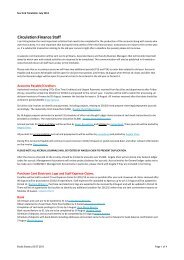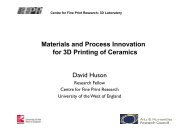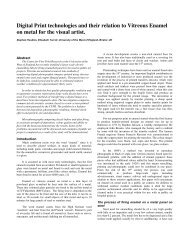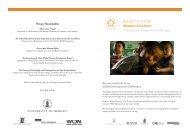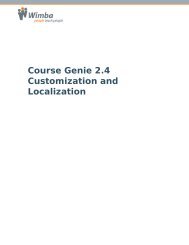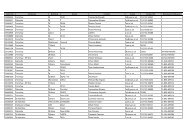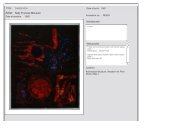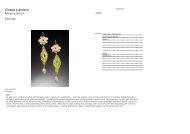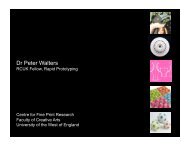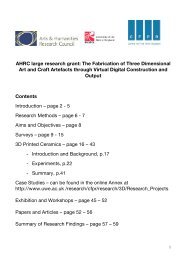Appendix 6 Guidelines on referencing - Welcome to UWE
Appendix 6 Guidelines on referencing - Welcome to UWE
Appendix 6 Guidelines on referencing - Welcome to UWE
Create successful ePaper yourself
Turn your PDF publications into a flip-book with our unique Google optimized e-Paper software.
<str<strong>on</strong>g>Appendix</str<strong>on</strong>g> 6<str<strong>on</strong>g>Guidelines</str<strong>on</strong>g> <strong>on</strong> <strong>referencing</strong>CONTENTS1 GENERAL PRINCIPLES................................................................................22 PLAGIARISM .................................................................................................23 WHY DO WE REFERENCE? .........................................................................24 REFERENCING SYSTEMS............................................................................34.1 HARVARD REFERENCE SYSTEM............................................................................................ 34.2 WHAT IS A REFERENCE? .......................................................................................................... 35 PARAPHRASING...........................................................................................35.1 HOW TO REFERENCE PARAPHRASED INFORMATION/EVIDENCE ................................. 56 HOW TO USE QUOTATIONS ........................................................................66.1 HOW TO REFERENCE A DIRECT QUOTATION..................................................................... 67 HOW TO REFERENCE SECONDARY SOURCES IN THE TEXT.................88 USING ET AL .................................................................................................89 REFERENCING AUTHORS WITH MANY PUBLICATIONS IN ONE YEAR..910 GREY LITERATURE ......................................................................................911 REFERENCING SOURCES FOUND ONLINE .............................................1012 HOW TO WRITE THE REFERENCE LIST...................................................1112.1 FOR ELECTRONIC ARTICLES / BOOKS:............................................................................1112.2 JOURNAL ARTICLES:............................................................................................................1212.3 BOOKS AND PAMPHLETS:...................................................................................................1312.4 CHAPTERS IN EDITED BOOKS:...........................................................................................1412.5 NEWSPAPER ARTICLES: ......................................................................................................1412.6 CONFERENCE PAPERS: ........................................................................................................1412.7 THESES: ...................................................................................................................................1512.8 OFFICIAL PUBLICATIONS: ..................................................................................................1512.9 PRESS RELEASES:..................................................................................................................1512.10 SECONDARY SOURCES:.......................................................................................................1512.11 TV BROADCASTS AND VIDEOS .........................................................................................1512.12 CD ROMS .................................................................................................................................1512.13 WEBSITES: ..............................................................................................................................1512.14 PERSONAL COMMUNICATIONS INCLUDING E-MAIL...................................................1613 BIBLIOGRAPHIES .......................................................................................1614 FURTHER HELP ..........................................................................................161
1 GENERAL PRINCIPLESWhile the accepted method for <strong>referencing</strong> for the Faculty of Health and SocialCare at The University of the West of England (Bris<strong>to</strong>l) is Harvard, it isrecognized that there are some variati<strong>on</strong>s of presentati<strong>on</strong> within this method. Themain thing is <strong>to</strong> present c<strong>on</strong>sistency of <strong>referencing</strong> within a piece of work.Academic writing follows certain c<strong>on</strong>venti<strong>on</strong>s. Learning about these c<strong>on</strong>venti<strong>on</strong>sis like learning any new skill and requires practice. Writing an academicassignment is not like writing a casual letter <strong>to</strong> a friend or a diary entry; althoughin some of your assignments you will be required <strong>to</strong> blend a range of differentwriting styles.When you write an assignment or an essay any facts, ideas and theories that youwrite about, which are not your own, need <strong>to</strong> be credited <strong>to</strong> their original author.The pers<strong>on</strong> who marks your assignment will wish <strong>to</strong> know the sources of yourknowledge.Clear <strong>referencing</strong> is required <strong>to</strong> enable the reader <strong>to</strong> distinguish between thoseideas which are yours and those which originated from others. Without this cleardistincti<strong>on</strong> there is a risk of committing plagiarism or literary theft through usingsome<strong>on</strong>e else’s work without clear acknowledgement of ownership. You MUSTNOT directly copy informati<strong>on</strong> from published sources e.g. books, journals, theinternet etc. or cite other people’s ideas without clear citati<strong>on</strong> of source as thiswould result in the assessment offence of plagiarism.There is a formal way of acknowledging some<strong>on</strong>e else’s ideas/work in your pieceof writing and below are guidelines <strong>to</strong> help you understand how <strong>to</strong> do this.2 PLAGIARISMPlagiarism means using the work of others without acknowledging your source ofinformati<strong>on</strong> or ideas.Failure <strong>to</strong> acknowledge the source of an idea and/ or extensive copying from asource without direct quotati<strong>on</strong> (by retaining, with <strong>on</strong>ly slight adjustment theoriginal terms, phrases, style and organisati<strong>on</strong> of ideas) are types of plagiarism.3 WHY DO WE REFERENCE?• To dem<strong>on</strong>strate evidence of reading from a range of sources.• To acknowledge the debt <strong>to</strong> other authors.2
• To show that a depth of knowledge supports your writing based <strong>on</strong> thewriting of others.• So that people reading your work can easily follow up your sources.• To validate claims and arguments.4 REFERENCING SYSTEMSThere are several different <strong>referencing</strong> systems in use and you will find varioussystems used in different publicati<strong>on</strong>s. When submitting assessed work withinthe Faculty of Health and Social Care, University of the West of England (Bris<strong>to</strong>l),you MUST use the Harvard Referencing System, a summary of which follows.4.1 HARVARD REFERENCE SYSTEMIn the Harvard system, the name of the author and the year of publicati<strong>on</strong> of thework appear in the text, and the work is cited in full in the reference list at the endof the essay or dissertati<strong>on</strong> (examples of this will appear later in this secti<strong>on</strong>).4.2 WHAT IS A REFERENCE?A reference involves naming, or citing, the author of a published work in your textand including full details of that work in your reference list.The following three headings outline the main ways in which you may use theideas, arguments and view of others in your writing and include examples <strong>to</strong> helpyou. The three headings are:1. Paraphrasing2. How <strong>to</strong> reference informati<strong>on</strong>/evidence that you have paraphrased3. How <strong>to</strong> use quotati<strong>on</strong>s5 PARAPHRASINGIn paraphrasing another’s ideas you aim <strong>to</strong> c<strong>on</strong>vey the essential aspects of thoseideas in your own words and style. Paraphrasing enables you <strong>to</strong> dem<strong>on</strong>strateyour understanding and interpretati<strong>on</strong> of a subject and is therefore preferable <strong>to</strong>the use of quotati<strong>on</strong>s.While it is a standard part of academic work, the paraphrase is often whereplagiarism occurs. An inability <strong>to</strong> paraphrase properly, that is, without unduereliance <strong>on</strong> the form and language of the original, suggests that you have notreally unders<strong>to</strong>od the original.EXAMPLE3
The following illustrati<strong>on</strong>s of incorrect and correct paraphrase are taken fromTurabian’s book, pp 54-56.ORIGINAL VERSION:‘Am<strong>on</strong>g the novel objects that attracted my attenti<strong>on</strong> during my stay in the UnitedStates, nothing struck me more forcibly than the general equality of c<strong>on</strong>diti<strong>on</strong>am<strong>on</strong>g the people. I readily discovered the prodigious influence that this primaryfact exercises <strong>on</strong> the whole of society; it gives a peculiar directi<strong>on</strong> <strong>to</strong> publicopini<strong>on</strong> and a peculiar tenor <strong>to</strong> the laws; it imparts new maxims <strong>to</strong> the governauthorities and peculiar habits <strong>to</strong> the governed.’(De Tocqueville, A. 1959, p.55).PLAGIARISED VERSION:Am<strong>on</strong>g the new things that attracted De Tocqueville during his visit <strong>to</strong> the UnitedStates, nothing impressed him more than the equality of the people. He easilydiscovered the stupendous influence that this equality had <strong>on</strong> the whole courseof society; lending a peculiar directi<strong>on</strong> <strong>to</strong> public opini<strong>on</strong>, special meaning <strong>to</strong> thelaws, new principles <strong>to</strong> those who governed, and distinctive habits <strong>to</strong> thegoverned.As Turabian points out, the plagiarised versi<strong>on</strong> is marked by an awkwardness ofpresentati<strong>on</strong>, due in part <strong>to</strong> the attempt <strong>to</strong> disguise the original through minorword and phrase changes, and a mis-representati<strong>on</strong> of ideas in the original; forexample, “equality of c<strong>on</strong>diti<strong>on</strong>” in the original becomes “equality of the people” inthe plagiarised versi<strong>on</strong>, although the two phrases are by no means syn<strong>on</strong>ymous.Finally, though De Tocqueville is menti<strong>on</strong>ed, no proper credit is given for theideas through explicit citati<strong>on</strong> of sources.AN ACCEPTABLE VERSION:Nothing of the new that he saw in the United States more impressed DeTocqueville than the ‘general equality of c<strong>on</strong>diti<strong>on</strong>’ of its people. This he sawreflected in every aspect of their life, giving a distinctive set <strong>to</strong> public opini<strong>on</strong>,laws and habits and determining new principles of government (De Tocqueville,1959, p.55).In this versi<strong>on</strong> the source is acknowledged, the ideas are expressed in a clear,c<strong>on</strong>sistent way and the author chooses <strong>to</strong> quote directly the key phrase ratherthan run the risk of a misleading paraphrase.4
5.1 HOW TO REFERENCE PARAPHRASED INFORMATION/EVIDENCEIn the text, give the author’s name and the year of publicati<strong>on</strong> <strong>on</strong>ly, using theformat Author (Year) or (Author, Year).EXAMPLENutbeam (1998) identifies optimal c<strong>on</strong>tact with the defined target group as a keyelement of success and therefore c<strong>on</strong>siders determinati<strong>on</strong> of the extent and levelof exposure as essential <strong>to</strong> the evaluati<strong>on</strong> of a health promoti<strong>on</strong> interventi<strong>on</strong>.Percepti<strong>on</strong>s of usefulness, relevance and feasibility are integral <strong>to</strong> programmeacceptability (Nutbeam, 1998).REFERENCE: (As it would appear in the reference list at the end of theessay).EXAMPLENutbeam, D. (1998) Evaluating health promoti<strong>on</strong> – progress, problems andsoluti<strong>on</strong>s. Health Promoti<strong>on</strong> Internati<strong>on</strong>al, 13(1), 27-44If there are two authors, give both names. When there are three or moreauthors, use the abbreviati<strong>on</strong> ‘et al’ meaning “and others” in the text (but list allauthors in full in your reference list).EXAMPLELewis and Bor (1994) found that 64.8% of nurses rarely, or never, includedquesti<strong>on</strong>s about sexuality when admitting a patient <strong>to</strong> the ward.Smith et al (1996) report that nicotine replacement therapy is safe and well<strong>to</strong>lerated by adolescents when provided in the form of patches.REFERENCE: (as it would appear in the reference list at the end of theessay).EXAMPLELewis, S. and Bor, R. (1994) Nurses’ knowledge of and attitudes <strong>to</strong>wardssexuality and the relati<strong>on</strong>ship of these with nursing practice. Journal of AdvancedNursing, 20, 251-259Smith, T.A., House, R.F., Croghan, I.T., Gauvin, T.R., Colligan, R.C., Offord,K.P., Gomez-Dahl, L.C. and Hurt, R.D. (1996) Nicotine patch therapy inadolescent smokers. Pediatrics, 98(4), 659-6675
6 HOW TO USE QUOTATIONSA quotati<strong>on</strong> is a direct copy of part of the original; it may be a single word,phrase, part of a sentence, whole sentence, or a short paragraph.Quotati<strong>on</strong> should not be used excessively, but mainly when no other wordscould adequately express the meaning.Any direct quotati<strong>on</strong> should be accurate <strong>to</strong> the original, even if the originalincludes errors of spelling, punctuati<strong>on</strong>, etc.You should be c<strong>on</strong>sistent in the ways in which you arrange quotati<strong>on</strong>s in the tex<strong>to</strong>f your assignment.6.1 HOW TO REFERENCE A DIRECT QUOTATIONAll quotati<strong>on</strong>s need <strong>to</strong> include reference <strong>to</strong> the author, year of publicati<strong>on</strong> andpage number (in the text) so that the reader can locate the source should theywish <strong>to</strong> do so.For short quotati<strong>on</strong>s (less than <strong>on</strong>e sentence), the quoted passage is locatedwithin quotati<strong>on</strong> marks (‘….’) and use the formats: Author (Year, Page No.) or(Author, Year, Page No.), depending <strong>on</strong> where the reference is situated withinthe sentenceEXAMPLEExamples cited by Ovretviet et al (1997, p.2) <strong>to</strong> illustrate the nature ofinterprofessi<strong>on</strong>al working include reference <strong>to</strong> a polarity with ‘referral <strong>to</strong> anotherprofessi<strong>on</strong>al’ at <strong>on</strong>e end and ‘working <strong>to</strong>gether as co-therapists at the other’orThe nature of interprofessi<strong>on</strong>al working has been referred <strong>to</strong> as a polarity with‘referral <strong>to</strong> another professi<strong>on</strong>al’ at <strong>on</strong>e end and ‘working <strong>to</strong>gether as cotherapists’at the other (Ovretviet et al, 1997, p.2).REFERENCE: (as it would appear in the reference list at the end of theessay).6
Ovretveit, J., Mathias, P. and Thomps<strong>on</strong>, T. (1997) Introducti<strong>on</strong>. In: Ovretveit, J.,Mathias, P. and Thomps<strong>on</strong>, T. (eds) Interprofessi<strong>on</strong>al working for health andsocial care. Basings<strong>to</strong>ke: Macmillan, pp1-8For l<strong>on</strong>g quotati<strong>on</strong>s (<strong>on</strong>e sentence of more) the quote is indented and quotati<strong>on</strong>marks are not required.EXAMPLERussell and Hymans (1999) draw <strong>on</strong> the work of Harbaugh (1994) and Carlt<strong>on</strong>(1984) <strong>to</strong> define interprofessi<strong>on</strong>al collaborati<strong>on</strong> asinteracti<strong>on</strong> between or am<strong>on</strong>g the members of two or more disciplinesinvolving professi<strong>on</strong>als who work <strong>to</strong>gether, with intenti<strong>on</strong>, mutual respect,and commitment for the sake of a more adequate resp<strong>on</strong>se <strong>to</strong> a humanproblem (Russell & Hymans, 1999, p.255).If part of the original text is omitted from the quotati<strong>on</strong>, this should be indicated bythe use of three full s<strong>to</strong>ps (…). For example,interacti<strong>on</strong> between or am<strong>on</strong>g the members of two or more disciplinesinvolving professi<strong>on</strong>als who work <strong>to</strong>gether, with intenti<strong>on</strong>, (…) andcommitment for the sake of a more adequate resp<strong>on</strong>se <strong>to</strong> a humanproblem (Russell & Hymans, 1999, p.255).If the omissi<strong>on</strong> falls at the end of the sentence, use four full s<strong>to</strong>ps, thusinteracti<strong>on</strong> between or am<strong>on</strong>g the members of two or more disciplinesinvolving professi<strong>on</strong>als who work <strong>to</strong>gether, with intenti<strong>on</strong>, mutual respect,and commitment (….) (Russell & Hymans, 1999, p.255).REFERENCE: (as it would appear in the reference list at the end of theessay)Russel, K.M. and Hymans, D. (1999) Interprofessi<strong>on</strong>al Educati<strong>on</strong> forUndergraduate Students. Public Health Nursing 16(4) 254-262TOP TIPWhen making notes from a source use a different coloured pen <strong>to</strong>distinguish between the author’s words and your own.TOP TIPKeep a full record of all sources used, as you go al<strong>on</strong>g, <strong>to</strong> enable you <strong>to</strong>c<strong>on</strong>struct a reference list.7
7 HOW TO REFERENCE SECONDARY SOURCES IN THE TEXTThe examples given so far assume that you have read the work you are referring<strong>to</strong>.In some cases you may wish <strong>to</strong> quote a piece of work that has been referred <strong>to</strong> insomething you have read. This is classified as a sec<strong>on</strong>dary source.Sec<strong>on</strong>dary sources should <strong>on</strong>ly be used in excepti<strong>on</strong>al circumstances, forexample, when the original source is not available.In the text you should cite the primary source and the source you have read(the sec<strong>on</strong>bdary source). Here are examples of how this can be d<strong>on</strong>e:EXAMPLEGhaziuddin (2005) refers <strong>to</strong> Aman’s 1995 evidence that…Aman (1995, cited by Ghaziuddin 2005) reports that…..Ghaziuddin (2005, citing Aman 1995) reports that……There is evidence <strong>to</strong> support that ……..(Ghaziuddin, 2005, citing Aman 1995)NOTEThe 2005 (in the example above) refers <strong>to</strong> the year of publicati<strong>on</strong>.REFERENCE: (as it would appear in the reference list at the end of theessay)Ghaziuddin, M. ( 2005) Mental health aspects of autism and Asperger syndrome.L<strong>on</strong>d<strong>on</strong>: Jessica Knightley PublishersNOTEIn the reference list use <strong>on</strong>ly the source that you have read.8 USING ET ALWhen you cite a reference that has more than two authors, within the text, youshould refer <strong>to</strong> the first named author followed by et al.8
(see the Smith et al example under Paraphrasing, secti<strong>on</strong> 5)Remember that the full list of authors will appear in your reference list at the endof your essay.9 REFERENCING AUTHORS WITH MANY PUBLICATIONS INONE YEARWhen an author has written more that <strong>on</strong>e publicati<strong>on</strong> within the same year andreference needs <strong>to</strong> be made <strong>to</strong> several works published in that year the letters a,b, c are used after the year <strong>to</strong> differentiate each publicati<strong>on</strong>.EXAMPLEAl<strong>on</strong>gside this there has been an increasing emphasis <strong>on</strong> teamwork as a meansof ensuring the most effective and efficient provisi<strong>on</strong> of health and social care(Nati<strong>on</strong>al Health Service Management Executive, 1993; DoH, 1996a, 1996b).REFERENCE: ( as it would appear in the reference list at the end of youressay)NHS Management Executive (1993) Nursing in primary health care – new world,new opportunities. L<strong>on</strong>d<strong>on</strong>: NHSME.Department of Health (1996a) Primary care: delivering the future. L<strong>on</strong>d<strong>on</strong>: HMSODepartment of Health (1996b) The health of the nati<strong>on</strong>: building bridges. A guide<strong>to</strong> arrangements for interagency working for the care and protecti<strong>on</strong> of severelymentally ill people. Wetherby: Department of Health.10 GREY LITERATUREThis term refers <strong>to</strong> publicati<strong>on</strong>s and informati<strong>on</strong> that have not been formallypublished through the usual commercial publishing houses, such as, OpenUniversity Press, Taylor & Francis. The work may be issued, in print orelectr<strong>on</strong>ically, by academics, government or organisati<strong>on</strong>s and would includematerial such as reports, c<strong>on</strong>ference papers, theses, newsletters and bulletins.Several websites or databases exist <strong>to</strong> help students and researchers find ‘greyliterature’ relevant <strong>to</strong> their area of study. Visit the British Library website forrecords <strong>on</strong> British reports, doc<strong>to</strong>ral theses and c<strong>on</strong>ferences (www.bl.uk). Use<strong>UWE</strong> Library <strong>to</strong> access similar material through useful databases such asCaredata and HMIC (Health Management Informati<strong>on</strong> C<strong>on</strong>sortium).9
EXAMPLEW<strong>on</strong>ham (2000) refers <strong>to</strong> the m<strong>on</strong>i<strong>to</strong>ring procedure in a BSc H<strong>on</strong>s thesis.REFERENCE: ( as it would appear in the reference list at the end of theessay).W<strong>on</strong>ham, L.P. (2000) Care provisi<strong>on</strong> and m<strong>on</strong>i<strong>to</strong>ring of elderly housebounddiabetics: a literature review. ( BSc H<strong>on</strong>s). University of the West of England11 REFERENCING SOURCES FOUND ONLINEThe Harvard <strong>referencing</strong> system existed well before the inventi<strong>on</strong> of the internetand as yet there are no fully accepted standards as regards <strong>on</strong>line <strong>referencing</strong>.The main thing <strong>to</strong> remember here is that, as far as possible, Harvard <strong>referencing</strong>rules apply.• Wherever possible use author and year of publicati<strong>on</strong> in the text.• There is no need <strong>to</strong> cite the web in the text.The full website address appears in the reference list. See examples of thecorrect method of doing this under How <strong>to</strong> write the reference list, from secti<strong>on</strong>12 <strong>on</strong>wards.If there is no author or date of publicati<strong>on</strong> <strong>on</strong> the material you wish <strong>to</strong> referenceyou should questi<strong>on</strong> the validity of the source. Also, <strong>on</strong>e of the reas<strong>on</strong>s for givingaccurate references is so that a source can be followed up by some<strong>on</strong>e readingyour work. If you cannot state the author and year of publicati<strong>on</strong> this follow-upbecomes difficult.Some reputable websites, for example, The Department of Health (DoH) producereports with no named author. If you wish <strong>to</strong> cite such documents you canidentify the corporate author, for example, DoH as both author and publisher.EXAMPLEThe DoH (2005) has proposed a plan for making healthier choices.REFERENCE: ( as it would appear in the reference list at the end of theessay).Department of Health (2005) Delivering choosing health: making healthierchoices easier, [<strong>on</strong>line]. L<strong>on</strong>d<strong>on</strong>: DoH. Availablefrom:http://www.dh.gov.uk/publicati<strong>on</strong>s [Accessed 22 June 2005]10
Most documents will c<strong>on</strong>tain a year of publicati<strong>on</strong> which is often located at theend of the document. If, however, you cannot find a year of publicati<strong>on</strong> look for adate the website was last updated and use this as a publicati<strong>on</strong> date. See lastexample under Journal articles secti<strong>on</strong> 12.212 HOW TO WRITE THE REFERENCE LISTAt the end of each piece of written work you should list the references which youhave cited directly in the text in alphabetical order by author in the styles givenbelow.If there is more than <strong>on</strong>e reference by the same author, list them in year order,and by letter (1993a), (1993b) if more than <strong>on</strong>e item has been published in thesame year. These same letters should appear with the year in brackets in thebody of the text.Each reference needs <strong>to</strong> c<strong>on</strong>tain enough informati<strong>on</strong> for the original work <strong>to</strong> beeasily tracked down.The main elements of any reference are: (starting in the left hand box below).Authorsurname/sInitial/sYear ofpublicati<strong>on</strong>(in brackets)TitleSource/journal title orplace andname ofpublisherAlthough for 3 or more authors the first named author and et al are used in thetext, all authors should be listed in the reference list.Other informati<strong>on</strong> is added as necessary – see examples belowAlways give the reference <strong>to</strong> the format that you have used, print or electr<strong>on</strong>ic.12.1 FOR ELECTRONIC ARTICLES / BOOKS:The reader needs <strong>to</strong> know:Authorsurname/sInitial/s Year ofpublicati<strong>on</strong>(in brackets).Plus for electr<strong>on</strong>ic resources:TitleSource/journal title orplace andname ofpublisher11
[<strong>on</strong>line] after the title Available from. ( URL) Accessed date [in squarebrackets]Always include [<strong>on</strong>line] after the title. You also need <strong>to</strong> include the date youaccessed the resource in square brackets at the end of the reference. Be asspecific as possible in the URL that you use. URLs can be copied from theaddress bar <strong>on</strong> the Internet page and pasted in<strong>to</strong> the reference in your list.Examples below follow current comm<strong>on</strong> practice.12.2 JOURNAL ARTICLES:The reader needs <strong>to</strong> know: (starting in the left hand box below and working fromleft <strong>to</strong> right).Authorsurname/sInitial/sYear ofpublicati<strong>on</strong>(in brackets)Title of articleTitle ofJournalin italicsVolumenumberPart number( in brackets)Pagenumber/s ofarticlePlus for electr<strong>on</strong>ic resources:[<strong>on</strong>line] after the title Available from. ( URL) Accessed date [in squarebrackets]J<strong>on</strong>es, P. (1978) The use of computer systems in patient care. Journal ofAdvanced Nursing, 5(1), 17-19In the above example the volume number is 5, the part or issue number is 1 andthe page numbers are 17-19Dim<strong>on</strong>d, B. (2004a) Legal forum: good character and good health. British Journalof Midwifery, 12(11), 710Dim<strong>on</strong>d, B. (2004b) Legal aspects of death. The cor<strong>on</strong>er’s jurisdicti<strong>on</strong> 1: thecurrent law in the UK. British Journal of Nursing, 13(19), 1151-1152In the above two examples, the two articles written by the same author in thesame year are distinguished by the additi<strong>on</strong> of a and b after the year in thebrackets. These same letters should appear with the date in brackets in the bodyof the text.12
Christensen, P. (2004) The health-promoting family: a c<strong>on</strong>ceptual framework forfuture research. Social Science and Medicine [<strong>on</strong>line], 59(2), 223-243. Availablefrom: http://www.sciencedirect.com/science/journal/02779536 [Accessed 5 May2004]Baldwin, C.M, et al. (2004) Complementary and alternative medicine: a c<strong>on</strong>ceptmap. BMC Complementary and Alternative Medicine [<strong>on</strong>line], 4:2 (13 February2004). Available from: http://www.biomedcentral.com/c<strong>on</strong>tent/pdf/1472-6882-4-2.pdf [Accessed 5 May 2004]The above journal is <strong>on</strong>ly published in digital format. There are no page numbers.Follow any <strong>on</strong>screen guidance for <strong>referencing</strong> that they supply. In this instancethe date of 13 February 2004 is the date of publicati<strong>on</strong>12.3 BOOKS AND PAMPHLETS:Authorsurname/sInitial/sYear ofpublicati<strong>on</strong>(in brackets)Title of bookin italicsSource/place andname ofpublisherPlus for electr<strong>on</strong>ic resources:[<strong>on</strong>line] after the title Available from. ( URL) Accessed date [in squarebrackets]Smith, R. (1994) Midwifery in community settings. 2nd ed. L<strong>on</strong>d<strong>on</strong>: SageShuttleworth, J. and Crowther, S. (eds) (1990) Future directi<strong>on</strong>s in therapeuticapproaches. Cambridge: Cambridge University PressHek, G., Judd, M. and Moule, P. (2002) Making sense of research: anintroducti<strong>on</strong> for health and social care practiti<strong>on</strong>ers. 2 nd ed. L<strong>on</strong>d<strong>on</strong>: C<strong>on</strong>tinuumDouglas, T. (2000) Basic groupwork. 2 nd ed. [<strong>on</strong>line]. L<strong>on</strong>d<strong>on</strong>: Routledge.Available from: http://www.netlibrary.com/Details.aspx [Accessed 13 April 2005]13
12.4 CHAPTERS IN EDITED BOOKS:The reader needs <strong>to</strong> knowAuthorsurname/sTitle of bookin italicsYear ofpublicati<strong>on</strong> ofBookInitial/sEditi<strong>on</strong>. ( if notthe first)Pagenumbers ofchapterYear ofpublicati<strong>on</strong>(in brackets)Volumenumber( if part of aseries)Title ofchapter.Place ofpublicati<strong>on</strong>In: Edi<strong>to</strong>r/s ofpublicati<strong>on</strong>with initials andsurnamefollowed by (edor eds inbrackets)PublisherPlus for electr<strong>on</strong>ic resources:[<strong>on</strong>line] after the title Available from. ( URL) Accessed date [in squarebrackets]Brown, S. (1990) Physiotherapy - quo vadis? In: J. Shuttleworth and S. Crowther(eds) Future directi<strong>on</strong>s in therapeutic approaches. Cambridge: CambridgeUniversity Press, pp 25-30Westmorland, L. (2000) Taking the flak: operati<strong>on</strong>al policing, fear and violence.In: G. Lee-Treweek and S. Linkogle (eds) Danger in the field: risk and ethics insocial research [<strong>on</strong>line]. L<strong>on</strong>d<strong>on</strong>: Routledge, pp 26-42. Available from:http://www.netlibrary.com [Accessed 25 May 2004]12.5 NEWSPAPER ARTICLES:Ward, D. (2005) UK’s first centre for abused children. Guardian [<strong>on</strong>line] 7 April.Available from: http://www.guardian.co.uk/child/s<strong>to</strong>ry/0,7369,1453690,00.html[Accessed 12 April 2005]12.6 CONFERENCE PAPERS:Silver, K. (1989) Electr<strong>on</strong>ic mail: the new way <strong>to</strong> communicate. In: D.I Raitt (ed)9 th Internati<strong>on</strong>al Informati<strong>on</strong> Meeting, L<strong>on</strong>d<strong>on</strong> 3-5 December 1998. Oxford:Learned Informati<strong>on</strong>, pp 323-330This is the same as <strong>referencing</strong> a book chapter, but includes the date of thec<strong>on</strong>ference as well as the publicati<strong>on</strong> date14
12.7 THESES:W<strong>on</strong>ham, L.P. (2000) Care provisi<strong>on</strong> and m<strong>on</strong>i<strong>to</strong>ring of elderly housebounddiabetics: a literature review. (BSc H<strong>on</strong>s). University of the West of England12.8 OFFICIAL PUBLICATIONS:Acts:Great Britain (1975) Social Security Act. L<strong>on</strong>d<strong>on</strong>: HMSOCommand papers:Department of Health (1997) The new NHS modern dependable. (Cm 3807).L<strong>on</strong>d<strong>on</strong>: The Stati<strong>on</strong>ery Office.In the above example Cm 3807 is the number of the command paperDepartmental reports:Department of Health (2002) Nati<strong>on</strong>al service framework for diabetes: deliverystrategy [<strong>on</strong>line]. L<strong>on</strong>d<strong>on</strong>: Department of Health. Available from:http://www.dh.gov.uk/assetRoot/04/03/28/23/04032823.pdf [Accessed 5 May2004]12.9 PRESS RELEASES:Department of Health (2005) Green paper <strong>on</strong> adult social care [<strong>on</strong>line] Pressrelease 2005/0127, 21 March 2005. L<strong>on</strong>d<strong>on</strong>: Department of Health. Availablefrom:http://www.dh.gov.uk/Publicati<strong>on</strong>sAndStatistics/PressReleases/PressReleasesNotices/fs/en?CONTENT_ID=4106702&chk=gZEiK5 [Accessed 7th April 2005]12.10 SECONDARY SOURCES:Reference the source that you have read. You do not need <strong>to</strong> list the originalresource in the reference list as well.12.11 TV BROADCASTS AND VIDEOSJulie through the looking glass. Teenage Diaries. BBC 2, 4 July 1992Alzheimer’s Society (2002) Yesterday, <strong>to</strong>day, <strong>to</strong>morrow: providing qualitydementia care. Video. York: Alzheimer’s Society12.12 CD ROMSInstitute of Cancer Research (2000) A breath of fresh air: an interactive guide <strong>to</strong>managing breathlessness in patients with lung cancer. [CD Rom]. Sutt<strong>on</strong>:Institute of Cancer Research12.13 WEBSITES:Use either a pers<strong>on</strong>al or corporate author if available. Otherwise use the title ofthe page. For the date, use the last updated or copyright date. Always include thedate accessed15
Nursing and Midwifery Council (2004) About the NMC [<strong>on</strong>line]. L<strong>on</strong>d<strong>on</strong>: Nursingand Midwifery Council. Available from: http://www.nmcuk.org/nmc/main/about/$aboutUsMain[Accessed 11 April 2005]12.14 PERSONAL COMMUNICATIONS INCLUDING E-MAILRoss, D.E. (1991) Pers<strong>on</strong>al communicati<strong>on</strong>Other, A. (Ann.Other@uwe.ac.uk), (15 June 2004) Procite bibliographic software.E-mail <strong>to</strong> J.Bloggs (Joseph.Bloggs@uwe.ac.uk)Pers<strong>on</strong>al references should be avoided if at all possible as they will be verydifficult <strong>to</strong> follow up and verify. Always seek the author’s permissi<strong>on</strong> before usingas a reference, especially when quoting an e-mail address.13 BibliographiesBibliographies are a useful way <strong>to</strong> identify sources that you have used but notreferred <strong>to</strong> directly in the text of your assignment. Such sources should berelatively few since those which have made a c<strong>on</strong>tributi<strong>on</strong> <strong>to</strong> your thinking shouldbe cited in the text. It is not necessary <strong>to</strong> include a reference in a bibliography ifit has already appeared in the reference list.Read the assessment guidelines carefully <strong>to</strong> identify whether or not abibliography is required in additi<strong>on</strong> <strong>to</strong> a reference list.14 Further HelpFor more informati<strong>on</strong> regarding <strong>referencing</strong>:• These guidelines can also be found <strong>on</strong> the faculty website at …….• Workshops <strong>on</strong> <strong>referencing</strong> are offered by the study skills tu<strong>to</strong>rs16



